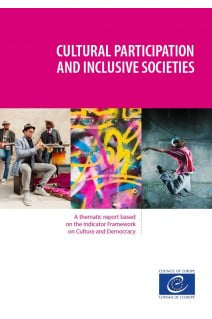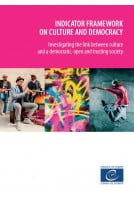



By enhancing cultural participation among Europeans, will the values of tolerance, trust and willingness to engage respectfully with others be strengthened, and more open, inclusive societies emerge as a result?
A link has been made in recent years between a strong, well-functioning democracy and an abundance of cultural opportunities for all. Societies are said to be more open, tolerant and economically successful when people have easy access to a wide range of cultural activities and when participation rates in these activities are high. This first Council of Europe thematic report on culture and democracy specifically explores the relation between cultural participation and aspects of inclusive societies in Europe, such as tolerance and trust, and underlines the potential power of culture in nurturing them.
The report is based on the Indicator Framework on Culture and Democracy, developed by the Council of Europe and the Hertie School of Governance, in co-operation with the European Cultural Foundation.
Contents
INTRODUCTION
CULTURAL PARTICIPATION AND INCLUSIVE SOCIETIES
Inclusive societies
Cultural participation
The role of culture and the arts in building inclusive societies
EXPLORING RELATIONSHIPS
Cultural participation and elements of inclusive societies
Cultural participation forms
Enhancing cultural participation
CONCLUSIONS
REFERENCES
APPENDIX 1 – THE INDICATOR FRAMEWORK ON CULTURE AND DEMOCRACY
APPENDIX 2 – COUNTRY SUMMARIES OF CULTURAL PARTICIPATION AND CULTURE-RELATED COMPONENTS AS MEASURED IN THE IFCD
LIST OF FIGURES
Figure 1: Cultural participation and tolerance
Figure 2: Cultural participation and generalised trust within societies
Figure 3: Artistic expression and creation and generalised trust
Figure 4: Online creativity and tolerance
Figure 5: Passive participation and generalised trust
Figure 6: Cultural participation and cultural industries
Figure 7: Cultural participation and cultural infrastructure


By enhancing cultural participation among Europeans, will the values of tolerance, trust and willingness to engage respectfully with others be strengthened, and more open, inclusive societies emerge as a result?
A link has been made in recent years between a strong, well-functioning democracy and an abundance of cultural opportunities for all. Societies are said to be more open, tolerant and economically successful when people have easy access to a wide range of cultural activities and when participation rates in these activities are high. This first Council of Europe thematic report on culture and democracy specifically explores the relation between cultural participation and aspects of inclusive societies in Europe, such as tolerance and trust, and underlines the potential power of culture in nurturing them.
The report is based on the Indicator Framework on Culture and Democracy, developed by the Council of Europe and the Hertie School of Governance, in co-operation with the European Cultural Foundation.
